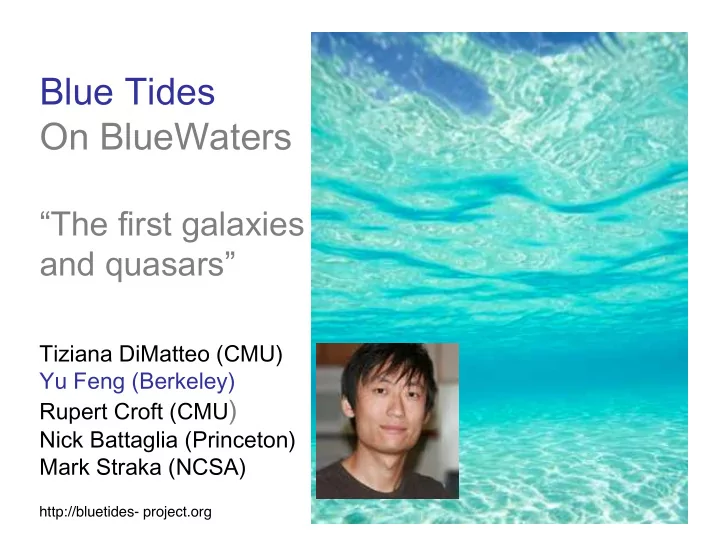

Blue Tides On BlueWaters “The first galaxies and quasars” Tiziana DiMatteo (CMU) Yu Feng (Berkeley) Rupert Croft (CMU ) Nick Battaglia (Princeton) Mark Straka (NCSA) http://bluetides- project.org
Cosmological Hydro Simulations: -Code used: PetaGadget (Petapps Cosmology) MBII MB -Physics: gravity, SPH, cooling, star formation, feedback, black holes . -Particle number: 2x3200 3 =64 billion 2x1800 3 =11.5 billion -Box size: 533 h -1 Mpc 100 h -1 Mpc - z final = 4.75 - z final = 0 (biggest SPH vol) - Runs using Kraken at NICS (>100k compute cores). Team : N. Khandai,Y. Feng, C.DeGraf R. Croft, V. Springel, E. Tucker
Cosmological Hydro Simulations: -Code used: MPGadget (Petapps Cosmology) -Physics: p-SPH, H2 +cooling, star BlueTides formation, feedback, black holes, Patchy Reionization . WHOLE BW run -Particle number: 2x7040 3 = 0.7triillion -Snapshots: 86 x (47 TB each) -Box size: 400 h -1 Mpc - z final = 7 (8) - Run using BlueWater at NCSA (648k compute cores). Team :, Y. Feng , DM, R. Croft, S. Bird, Battaglia
We resolve galaxies across the full mass function What we can resolve with 100 particles: Superclusters of galaxies Clusters of galaxies Milky way-sized galaxies MBII Dwarf galaxies
Algorithms keep up with computational power Hydro simulations: -trillion On 0.72m cores NCSA Cray XE6 -billion Blue Waters On 112k cores NICS Cray XT5 Kraken
MP-Gadget: Petascale cosmological code (P-Gadget3) Feng et al. 2015a,b, Code paper, in prep.
Short range force calculation: increased threading efficiency MBII kraken replaced global critical sections with spinlocks (per particle lock) and atomic increment operations 2 x speed-up
Long range force calculation (PM): New solver: E.g. 8 processes: Figure from M.Pippig 2013 Blue Tides: Pencil beam domain N= 10000 slabs decomposition on 81000 MPI ranks 8 x speed-up Open Source: Added new Array-execution interface and python binding to PFFT (http://github.com/mpip/pfft)
Domain decomposition: New global domain tree built on root rank. 10 x speed-up The communication is minimium, with one direction (comunication) communication from children to root-ranks in each sub- communicator, followed by a global broadcast of the fully merged tree to all computing ranks.
New parellel sorting module: MP-Sort: histogram based Sorting: exchange 1 data item exactly once: E.g sort 10 items on 2 MPI tasks Large impact on IO, FoF/galaxy catalogues “Sorting At Scale on BlueWaters” Y. Feng, M. Straka, R. Croft, TDM, 2015, CUG2015; Finalist of Best Paper. Open Source: http://github.com/rainwoodman/MP- sort
Code performance improvement for BlueTides Walltime per step
New Physical Modeling P-SPH formulation H2 Molecular cooling/ star formation Patchy Reionization (introducing spatially dependent UV field, Battaglia et al. ,2013) Mass dependent Supernova Wind
An example Problem : What are the first galaxies like? Hubble Legacy Deep Fields: galaxies at z=8-10
Current Hubble Legacy Deep Fields probe tiny regions.
BlueTides Simulation: Global SFRD is consistent with current observations. Star formation rate density Age: 500 Myrs Early universe redshift Feng et al., 2015a
BlueTides Simulation: Global SFRD is consistent with current observations. Star formation rate density WFIRST Deep Fields high z, Age: 500 Myrs Early universe redshift
Simulations like Observations: Create Mock Fields. Source extract detection to find galaxies
Galaxy Luminosity Function in BlueTides consistent with Hubble Legacy Fields (star formation rate) Diff. Number density of galaxies Cosmic variance Galaxy luminosity bright Feng et al., 2015a
Black Hole/AGN Luminosity Function in BlueTides Consistent Predictions for first quasars Diff. Number density of black Holes First super-bright quasars bright BH luminosity Feng et al., 2015a
What are the first galaxies like?
First galaxies are messy…. stars gas
z=8 Most massive (Milky Way) galaxies stars gas gas
z=8 Most massive (Milky Way) galaxies are disks! stars gas
z=8 Milky Way (/Massive) Halos look like disks! JWST Feng et al., 2015b
Star formation in BlueTides (subgrid): •Multiphase ISM (Springel 2003) •SFR depends on Metallicity/Molecular Hydrogen (Krumolz &Gnedin 2011) •Supernova Feedback/wind depends on Halo Mass (e.g. Okamoto 2010) BH subgrid model as before
The sizes of galaxies in BlueTides are consistent with HST observations --> larger disks in bright galaxies Feng et al., 2015a
What sources reionize the Universe? Galaxies and AGNs in BlueTides
BlueTides and Re-ionization history of the Universe Galaxies can reionize the universe for high escape photon fractions. But AGNs can contribute (very?) significantly Required photon ionization rate galaxies Galaxies AGN AGN AGN z z
Recommend
More recommend